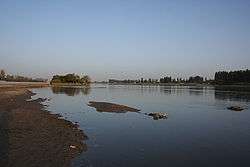Kaidu River
Coordinates: 42°2′45″N 86°35′36″E / 42.04583°N 86.59333°E

The Kaidu River (Chinese: 开都河; pinyin: Kāidū Hé), also known under its ancient name Liusha River (Chinese: 流沙河; pinyin: Liúshā Hé; literally: "Flowing Sands River") or Chaidu-gol is a river in the Xinjiang Uyghur Autonomous Region of China and an important source of water for the region.
The sources of the Kaidu River are located on the central southern slopes of the Tian Shan from where it flows through the Yulduz Basin[1] and the Yanqi Basin into Lake Bosten for which it is the most important tributary.[2] The river leaves the lake under the name Kongque River (Chinese: 孔雀河; pinyin: Kǒngquè Hé), which literally means "Peacock River", but is derived from the Uyghur name "Konchi Darya" which means "Tanner's River".[3] The Kongque River flows through the Iron Gate Pass (simplified Chinese: 铁门关; traditional Chinese: 鐵門關; pinyin: Tiĕmén Guān) into the Tarim Basin.
Cultural significance
In the Journey to the West, the Kaidu River is referred to as the Flowing Sands River and is the place where the river-ogre Sha Wujing terrorized the surrounding villages and travelers trying to cross the river, before becoming a disciple of Xuanzang.[4]
Settlements on the river
Kaidu River
Kongque River
References
- ↑ "Xinjiang River Guide"
- ↑ Seespiegelschwankungen des Bosten-Sees (German)
- ↑ Nara Shiruku Rōdo-haku Kinen Kokusai Kōryū Zaidan, Shiruku Rōdo-gaku Kenkyū Sentā: Opening up the Silk Road: the Han and the Eurasian world, Nara International Foundation Commemorating the Silk Road Exposition, 2007
- ↑ "Brief Introduction to Ba-Prefecture"